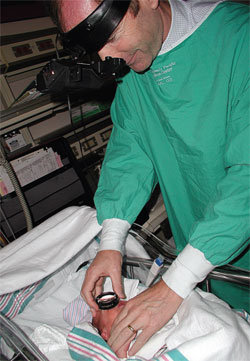 |
|
Infants of a lower birth weight and younger gestational age are more likely to develop ROP. Click image to enlarge. |
A recent study found that infants with a lower birth weight and younger gestational age are more likely to develop higher rates of retinopathy of prematurity (ROP) and severe ROP. The findings also uncovered a number of characteristics that further increase the risk of the condition among this patient population.
In this analysis, the study authors retrospectively reviewed the medical records of preterm infants who were screened for ROP. They included only one eye of each infant with higher grade ROP in the study. Birth weight, gestational age and medical characteristics as well as the presence, severity and need for treatment of ROP were recorded. Participants were divided into groups based on birth weight (≤1000g, 1001-1750g, >1750g) and gestational age (≤25 weeks, 26-28 weeks, 29-31 weeks, 32-34 weeks, ≥35 weeks).
The researchers evaluated data from 2,186 infants and found that the overall incidences of any stage of ROP and ROP requiring treatment were 43.5% and 8.0%, respectively. They reported that these rates were 81.1% and 23.9% in extremely low birth weight (≤1000g) infants vs. 92.9% and 64.3% in extremely young gestational age (≤25 weeks) infants, respectively.
Data showed that as birth weight and gestational age decreased, the rate of ROP, median duration of oxygen therapy and incidence of systemic disease increased significantly. When compared with infants without ROP, the median duration of oxygen therapy and the rates of sepsis, pulmonary dysplasia and intraventricular hemorrhage were statistically higher in infants with ROP.
The findings showed that in addition to lower birth weight and younger gestational age, prolonged duration of oxygen therapy, the presence of concomitant neonatal sepsis, pulmonary dysplasia, intraventricular hemorrhage, patent ductus arteriosus and necrotizing enterocolitis were also risk factors of ROP.
“Currently, extremely low birth weight and extremely low gestational age infants with increasing chances of survival have a high rate of developing ROP and severe ROP,” the study authors concluded in their paper. “In these infants, prolonged duration of supplemental oxygen therapy and increased systemic comorbidities increase the risk of ROP. Consequently, the lower the birth weight and gestational age, and the longer the exposure to supplemental oxygen, the greater the risk of developing any ROP and severe ROP.”
Patients with these risk factors should be followed closely for the development of this condition, according to the researchers, who emphasized the importance of informing families of these infants about their risks.
Yucel OE, Eraydin B, Niyaz L, et al. Incidence and risk factors for retinopathy of prematurity in premature, extremely low birth weight and extremely low gestational age infants. BMC Ophthalmol. September 13, 2022. [Epub ahead of print]. |


